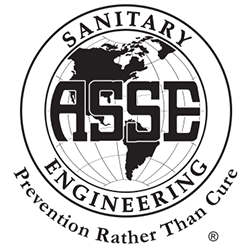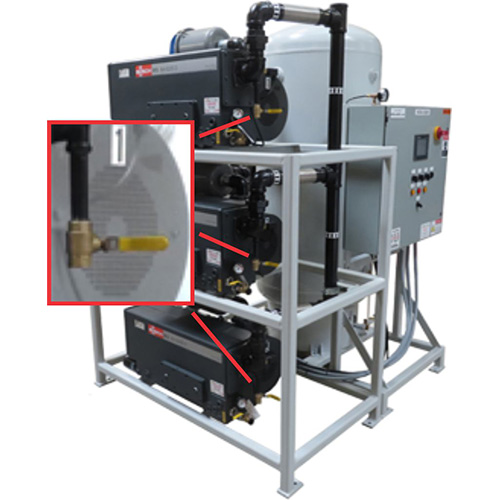In the world of lubricated medical vacuum pumps, running a pump out of oil is one of the greatest threats to the system. Oil is absolutely necessary in a lubricated pump. Oil lubricates and keeps the pump cool, efficient and running smoothly.
In normal day to day operations, vacuum pumps tend to pass a very minute amount of oil into the exhaust line. Internal separators are installed to help keep that oil from exiting the pump. A separator is a coalescing or “collection” filter. This means that the oil collected by the filter is dropped into the exhaust box and is recirculated back into the pump. As the separator(s) age, more and more particles will pass through the separator to the pump exhaust.
A good defensive tactic, to detect the loss of oil in a vacuum system, is to install a drip leg on each pump. The drip leg can be used to detect oil, atomized oil or water emitted from a vacuum pump. In this case, the leg is primarily used as an early warning indicator for vacuum system separator failure.
If a drip leg is installed on each vacuum pump, it should become a regular part of daily/weekly/monthly rounds of maintenance. The leg has a manual valve. Open this valve on a regular basis and release any liquid (oil, water, etc.) into a vessel such as a cup. Inspect the amount of liquid that is released by the pump. This can give huge clues as to the condition of the separators.
The first few rounds of opening the drip leg on a regular basis allows a baseline to be established for how much liquid is regularly emitted by the pump. It may also indicate that oil residue could be accumulating in the lines. At some point, larger amounts of oil may escape when the drip leg is opened. This indicates the separators may be beginning to fail, losing their effectiveness. A separator service at this time is a good preventative practice.
If the separator continues to fail, it starts to pass larger and larger droplets of oil. Under these conditions a vacuum pump can run out of oil in a relatively short period of time. Failure to replace the separators at this point could cause excessive oil usage and damage to the pump.
A failed separator could lead to a major malfunction and allow the oil to pass into the exhaust piping. Physically, this may appear as a very vague smoke. As the pump gets lower on oil, it will run hotter and hotter. Eventually, it could get hot enough to start a fire in the exhaust box.
A separator with a damaged or torn element could pass large amounts of oil into the exhaust box. If this condition occurs, the differential pressure gauge will be reading very low or even zero.
A few other indicators of separator failure might be:
- The vacuum pump is consistently losing oil
- A check valve could be malfunctioning
- A separator has been installed incorrectly
- The wrong lubrication can allow oil to pass through the separator
A lot of systems have one drip leg for all of their pumps. In this case, when the drip leg indicates there is an issue, it is difficult to know which pump is causing the problem. If each pump has its own drip leg, the faulty pump is identified immediately. Once identified, the pump can be isolated and serviced without causing distress to the entire system.
As we are performing our services, we see a lot of vacuum pump exhaust drains plumbed to floor sinks. This could allow hazardous waste to be discharged into the sewer. DID YOU KNOW? The Federal Clean Water Act, Title 40, Part 279 of the Code of Federal Regulations states that there be no more than 40ppm oil in wastewater drained into sewers. The fluid removed from a drip leg should be disposed of according to state and local hazardous waste disposal regulations.
Among other regular routines, servicing and replacing separators and oil filters at given intervals, is included in our Medical Vacuum Preventative Maintenance Program. Contact us for a complimentary equipment evaluation. We’ll get your equipment back on track in no time. Click to see how an airandvac Preventative Maintenance Program can save you money!










